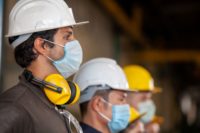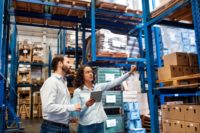As the pandemic continues, warehouse workers are still adapting. In particular, social distancing is essential to prevent the spread of the virus, keep employees safe, and maintain operations.
Even as residents in the United States get the vaccine, social distancing will continue to be of the utmost importance. The following five technologies have transformed warehouse work, keeping everyone safe in the process.
1. Remote work
Though remote work isn’t always possible for warehouse workers, managers and safety officers should implement it whenever they can. For instance, the more hands-off staff members may be able to work from home.
This trend is growing strong — more than 80% of employers plan to continue remote work even after the pandemic.
If remote work still isn’t a practical option, employees can use the technology that comes with it. Zoom or Skype for distanced meetings will keep people from congregating in one area.
If an employee gets sick, they’ll need to take time off or work from home immediately. Of course, these two practices won’t cover every social-distancing need in the workplace. Fortunately, it’s one of many tech-based solutions.
2. Robotics
New robotic systems help automated processes that would otherwise require several employees in one space. Warehouses commonly use robotic arms for manufacturing or assembling products. However, managers can take it further.
Some robots use artificial intelligence (AI) to unload trucks of inventory. Once the shipment arrives, the robot analyzes the contents and decides on the best method for unpacking. The process is fast, efficient, and socially distant.
In addition, other robots can autonomously navigate throughout the warehouse and retrieve items in storage, keeping people distant. This method also reduces the chances of worker injury as the robots go into trickier or more dangerous locations instead.
3. Wearables
Wearable technology is one of the most accessible and practical solutions for social distancing in the warehouse. These gadgets are small, and workers can wear them around their wrists or on their belts.
Notably, Amazon.com employees are now using wearable technology in the company’s warehouses. Using sensors, the devices alert workers if they come within six feet of other employees. This way, once the noise or vibration goes off, they can quickly separate and continue to maintain social distancing.
The key to this tech is simple: measurement-detection tools, like lasers, connect through Bluetooth or GPS from one device to another. It’s a simple integration that keeps everyone safe.
4. Cameras
Cameras have also become a ubiquitous tool to monitor the distance between employees in warehouses. AI-based cameras can track several factors — mask-wearing, heat signatures, and physical distance. If an employee isn’t wearing a mask or is too close to someone else, the system can alert them.
In addition, the thermal heat signature provides a bonus for detecting fevers. Then, employees can take the right steps to protect themselves and others.
Amazon.com has been using cameras, too, to aid social distancing. However, the main factor here will be ensuring the workplace balances safety with employee privacy.
5. Contact-tracing apps
If there is a case of COVID-19 in the warehouse, employers must take immediate action to prevent it from spreading. The best way to do so is through contact tracing.
A contract-tracing app or system will log who comes into contact with whom, and alert them if they have potentially been exposed to the virus. They’ll then take the appropriate steps to get tested and isolate if necessary.
Some states, like New Jersey, have apps for contact tracing. However, managers can also work with apps specific to industry work. For instance, Kinetic Reflex combines proximity detection and contact tracing into one simple device.
Safer warehouses for the future
These five technologies are easy to implement and work efficiently to keep everyone at a safe distance. As vaccines are still rolling out across the country, these technologies are the best way to ensure warehouse work is as safe as possible.



